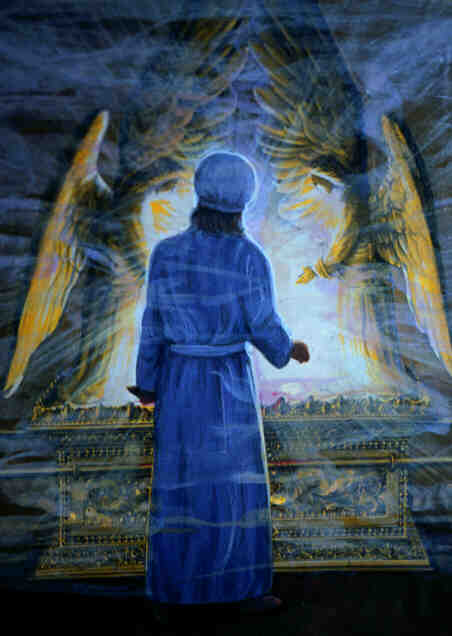
 8
JOHANNINE ESSAYS
8
JOHANNINE ESSAYS
 The High Priestly Prayer of John 17
(10 November 1982)
The High Priestly Prayer of John 17
(10 November 1982)
by Christopher C. Warren, M.A.(Oxon)

Intro | 1 | 2 | 3 | 4 | 5 | 6 | 7 | 8 | 9 | 10 | 11
12 | 13 | 14 | 15 | 16 | 17 | 18 | 19 | 20 | 21
The High Priestly prayer of Yah'shua (Jesus) is the longest prayer on record anywhere in the New Testament and contains a large number of important theological ideas. It differs from the prayer in the Synoptic accounts which is recorded in order to show readers the inner truth of the coming passion and resurrection. Yah'shua (Jesus) there speaks of His sorrow and asks that the cup of suffering be removed from Him whilst submitting Himself to the Father's will. That is to say, the reader is shown that the crucifixion is accepted by Yah'shua (Jesus) in obedience to the Father, but at great cost to Himself. The High Priestly prayer in John 17 is also recorded to demonstrate the truth about the crucifixion and resurrection, but here there is no mention of the sorrow of Yah'shua (Jesus). In fact, no distress is mentioned at all. Now could it be, it may be argued, after the assurance of joy and victory that Yah'shua (Jesus) had given to the disciples in the previous chapter.
The Johannine prayer affirms once again the divinity of Christ and His omnipotence. He has power over all flesh and can bequeath eternal life on anyone who accepts Him and His Father. The prayer reaffirms the doctrine of Christ's pre-existence, mentioned only once before in the prologue, and the glory He shared with the Father in this ante-mortal state. The recurrent duality theme so characteristic of Johannine writing finds itself included in the prayer - the Father and the Son are two distinct personages or manifestations, they are equal in power, glory and majesty, yet the Son remains subject to the Father always. Thus the concept that Christ is the Father's earthly executor is confirmed. Christ confirms that he has taught His Father's doctrine as instructed and that this doctrine (the Word) has been received by the Elect and been adhered to. The testimony that Yah'shua (Jesus) has proceeded from the Father is accepted by them and so the work of evangelising the world may continue. We find also in this prayer the idea of Christ as Intercessor for man - the mediator between humankind and the Father - pleading their case with the Heavenly throne, affirming again Yah'shua's (Jesus') dependence on the Father for all the power, glory, and majesty that He possesses. The prayer emphasises again the unity (oneness or echad) of the Godhead which is conceived as being composed of two Persons: the Father and the Son. We do not find the concept of the Trinity in the prayer which evolved far later as a Christian doctrine although some commentators suggest that John alludes to his doctrine in places elsewhere in his writings. I personally do not see this and certainly do not find evidence for Trinitarian concepts in John's High Priestly prayer of Yah'shua (Jesus).

We find in the prayer a wholly new concept too, namely, Perdition. This is its only reference in the gospel and is mentioned only in one other place in the Johannine corpus, namely the Apocalypse or the Revelation of John. The word 'perdition' here specifically refers to Judas Iscariot and means 'damnation'. It is not clear whether perdition is a place or a state of inner being; since the term is also used by Paul to describe Satan it could refer to either. However, it is my personal view that it refers only to a spiritual condition and not to a literal Purgatory though it is impossible to prove either contention on the scant material available to us. As with the Trinity doctrine, the concept of a place for the wicked must have evolved from the diea of perdition and of hell, to counter the Paradise spoken of elsewhere. I assume Paradise to be both a place and a spiritual condition in the light of the account of Calvary in the synoptic gospels.
Yah'shua (Jesus), in talking to His Father, confirms that it is more important to live this life than it is to escape it and so enter into Paradise. The idea that the world exists to mature Christ's followers spiritually is amply testified to for Christ prays that they may remain on the earth and not be tempted by the evil one. They are to be consecrated as Yah'shua (Jesus) is consecrated. Here we find Christ comparing Himself to the High Priest offering the sacrifice of the Paschal (Passover) Lamb; so too are the disciples to become Paschal Lambs, shedding their blood as a testimony against the ungodly and as a testimony of the Word. Thus Christ effects a link between the Old and the New Testaments in His prayer.
Finally, Yah'shua (Jesus) prays not only for His followers there and then but also for those who will yet be converted to show that His work is ongoing and not in need of His physical presence. Thus the work of the Paraclete (Comforter, Counsellor) is emphasised indirectly. He prays for unity (oneness, echad) amongst the Elect as He and His Father are One (Echad) -- one in purpose and mind. Here again the duality of the Godhead is emphasised but not in the Trinitarian sense; Yahweh and Yah'shua (Jesus) are one in mind and not of substance, i.e. they are not two different manifestations of the same Being, no more than the disciples are manifestations of a single person. The Father and the Son are as distinct as the disciples are; the unity hereof spoken is one of purpose, mind, and doctrine, and not of being or substance. We therefore find John in stark opposition to the whole Trinitarian idea which was to later evolve in the Catholic Church under the influence of neo-Platonism and continued in the Protestant Reformation.
Thus we find the High Priestly prayer of Yah'shua (Jesus) containing numerous religious ideas. The all-embracing concept is in the idea of love, or charity, which permeates not only the whole prayer but the Gospel as a whole. It is a testimony of divine love which sheds itself abroad in the hearts of the believers.
Intro | 1 | 2 | 3 | 4 | 5 | 6 | 7 | 8 | 9 | 10 | 11
12 | 13 | 14 | 15 | 16 | 17 | 18 | 19 | 20 | 21


This page was created on 6 February 2004
Updated on 6 February 2004
Copyright © 1987-2008 NCCG - All Rights Reserved



